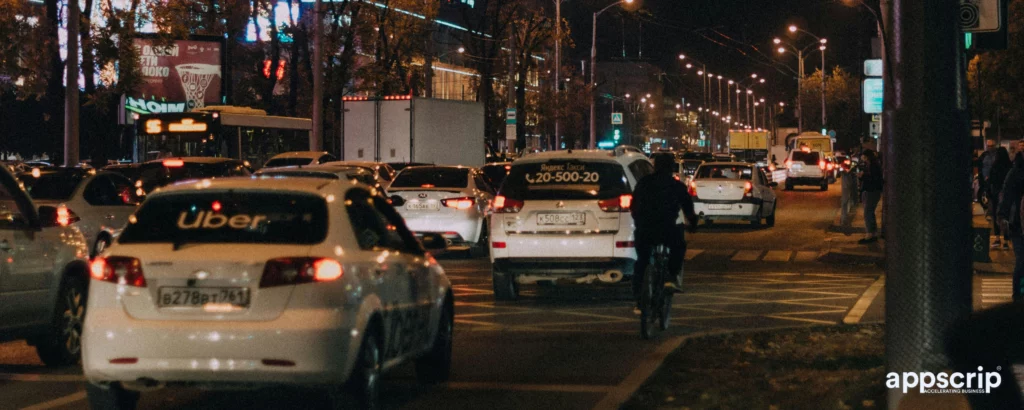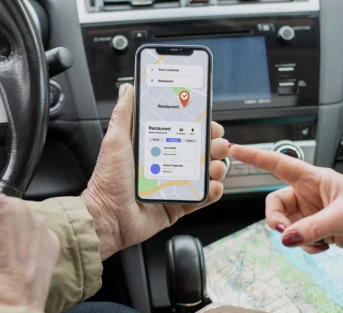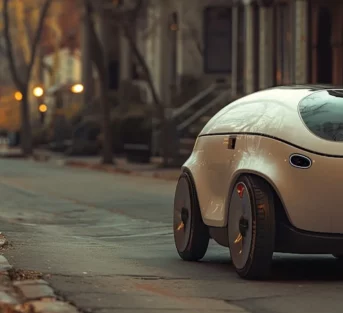Uber’s not just an app—it’s a global conglomerate that’s redefined how we travel. In 2024, Uber generated $43.9 billion revenue, witnessing an 18% increase YoY. In 2025, this number should touch $166 billion.
Whether you’re taking your first Uber ride or your hundredth, we’ve put together some rider tips for the first timers and for veterans, to make sure your ride experience, from request to drop-off, is hassle free.
Read on and you will get to know the in’s and out’s of how Uber app works.
TL;DR
- Revenue Growth: Uber earned 43.9Billion 2024
- Business Model:
- Takes 15-30% commission per ride.
- Uses surge pricing to balance supply and demand.
- Uber One subscriptions ($9.99/month) lock in loyalty with 25M members.
- Global Reach: Operates in 70+ countries, 15,000+ cities, and is expanding into Africa and Southeast Asia.
- Tech-Driven: AI powers ride-matching, dynamic pricing, and fraud detection.
- Key Stats: 150M monthly users, 8M drivers, and partnerships like Waymo for self-driving cars.
- For Entrepreneurs: Appscrip’s taxi dispatch software helps startups replicate Uber’s success.
- Innovation: Uber blends tech, scalability, and market capture to redefine transportation.
The Uber Business Model
How Uber Makes Money
Uber’s cash flow is a through a multi-pronged strategy:
- Commission-Based Revenue: Uber takes a cut of 15-30% on each fare. That means for every $20 ride, a commission of $3-$6 has to be borne by the driver. With 30.3 million daily trips in 2024, that’s a hefty haul of $43.9 billion in revenue last year.
- Surge Pricing: When demand spikes (could be various reasons like rush hour, bad climate, shortage of cabs or some event taking place) then the fares jump—sometimes doubling. It lures drivers to hot zones and pads Uber’s take, though it’s a much hated feature for riders.
- Subscriptions Like Uber One: For $9.99/month, 25 million members can avail free delivery, discounted rides, and VIP service. It’s a loyalty lock-in feature for those who value time. In 2022 this number was 12 million —this locks in an additional $300M+ in a year.
Key Stakeholders
Uber’s a three-way structure comprises of:
- Passengers: 150 million monthly users tap the app for rides, food, or freight. That is literally up 11% from 2023. They’re the demand that keeps cash registers jingling.
- Drivers: 8 million strong worldwide in 2024, their numbers are more made up of gig workers earning $500-$1,000/week. But the sad fact is only around 4% continue even after one year. Uber’s dangling surprises like referral bonuses to keep them on the rolls.
- Uber Platform: The primal member in this group is the—algorithms, servers, and Uber executives. In 2023, they earned around 28.7% on rides and 18.3% on delivery.
Market Expansion Strategy
Uber’s growth can put the Disney roller-coaster to shame:
- Global Scaling: From 70 countries to 15,000+ cities, Uber’s everywhere— in 2024 Uber had presence in over 900 metros. It’s eyeing Africa and South East Asia next, with 18% gross bookings growth in 2024 alone.
- Partnerships: Teaming with Waymo for self-driving rides in Phoenix (2023 rollout) and London’s black cabs (15,000 drivers joined by late 2024) keeps Uber lean and local.
- Acquisitions: Uber’s biggest acquisition was Postmates for $2.65B in 2020. And as a strategy to stay lean, it sold its self-driving ATG to Aurora for $4B in 2021.
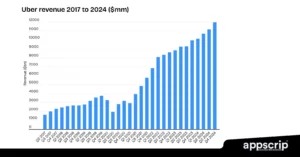
How Uber App Works – Step-by-Step Process
Uber’s ride-hailing service operates through a smooth tech-driven process that ensures convenience, efficiency, and security for both riders and drivers. Here’s how the Uber app works, step by step:
Step 1 – User Requests a Ride
- Any user would have to open the app and enter a destination.
- The app suggests ride options available at that time (UberX, UberXL, Uber Black, etc.) along with the estimated fare and arrival time.
- The user then selects their preferred ride type and confirms the pickup location.
- The rider also has the option to schedule a ride up to 90 days in advance.
Step 2 – Driver Matching Algorithm
- Uber’s ride-matching system which is AI-based searches for the nearest available driver.
- The matching algorithm then considers driver availability, proximity, and ride demand in real time.
- The ride request is served to the driver with the pickup location. The driver has the option to either accept or decline the ride.
- When a driver accepts the ride, the user is notified with the driver’s name, vehicle details, and estimated arrival time.
Step 3 – Ride Tracking & ETA Calculation
- Users can monitor their ride approaching with the help of real-time GPS tracking that is provided by the app.
- Uber integrates with Google Maps, Waze, and in-house navigation systems to optimize routes.
- AI-driven ETA (Estimated Time of Arrival) calculations factor in traffic conditions, weather, and roadblocks for accurate predictions.
Step 4 – Payment Processing
- Uber processes payments automatically once the ride is completed.
- Users can choose from multiple payment methods, including credit/debit cards, PayPal, Apple Pay, Google Pay, or cash (in select regions).
- Uber also applies dynamic pricing (surge pricing) based on demand, ensuring efficient ride allocation.
- Users receive an e-receipt via email and can view ride history in the app.
Step 5 – Ratings & Reviews
- After the ride, both riders and drivers rate each other on a scale of 1 to 5 stars.
- Riders can provide additional feedback, such as compliments or concerns.
- Uber uses ratings to maintain service quality—low-rated drivers may receive fewer ride requests, while highly-rated drivers can access more ride benefits.
- Uber also offers customer support for ride disputes, lost items, or complaints.
By integrating AI-driven algorithms, GPS navigation, real-time payments, and a robust rating system, Uber ensures a flawless and efficient ride-hailing experience for millions worldwide.
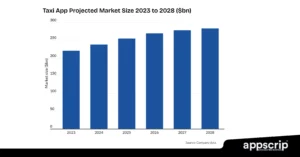
Uber’s Technology Stack & Core Features
Uber’s success is driven by a well proven and powerful technology stack that ensures hassle free ride-hailing, navigation, payments, and security process. Below is a breakdown of its core technologies and features.
Mobile App & Platform Development
Uber’s platform consists of mobile apps for riders and drivers, along with backend systems that handle requests in real time.
- Frontend Technologies – Uber’s mobile apps are built using Swift (iOS) and Kotlin (Android) so that there are separate apps, which ensures a smooth user experience for users.
- Backend Technologies – The core backend runs on Node.js, Python, Java, and Go. These technologies ensure fast response times and a comfortable user experience.
- APIs & Microservices – Uber follows a microservices architecture using gRPC, Apache Kafka, and REST APIs to handle millions of transactions per day.
GPS & Navigation System
For any ride-hailing service, accurate location tracking and efficient routing are crucial.
- Google Maps & Waze – Uber integrates with Google Maps API and Waze for real-time traffic updates and navigation.
- Route Optimization – Uber’s routing algorithm takes care to minimize detours. It selects the fastest routes using Dijkstra’s and A* algorithms. Dijkstra’s Algorithm finds the shortest paths from a single source node to all other nodes, while A* Algorithm is an efficient pathfinding algorithm that uses a heuristic function to search for the shortest path.
- Geofencing – Apps include geofencing as it has several functions. Firstly it enables surge pricing, it keeps drivers tuned to high-demand areas, and restricts services in certain zones.
Payment Gateway Integration
Uber supports multiple payment methods ensuring convenience and secure transactions.
- Secure Transactions – Uber implements PCI-DSS compliance to encrypt payment details and prevent fraud.
- Multiple Payment Methods – The platform accepts credit/debit cards, PayPal, digital wallets (Apple Pay, Google Pay), and cash in some regions.
- Automatic Fare Calculation – The system generates real-time fare estimates using factors such as distance, time, surge pricing, and promotions.
AI & Machine Learning in Uber
AI is a go-to technology for many firms, even Uber. Uber utilises AI to enhance ride efficiency, pricing, and fraud detection.
- Ride-Matching Algorithm – Machine learning optimizes driver-rider matching, reducing wait times and maximizing driver earnings.
- Dynamic Pricing (Surge Pricing) – Surge pricing has come into the picture with the help of AI. AI adjusts fares taking into consideration the demand, weather, location, and traffic conditions. This also helps to balance supply and demand.
- Fraud Detection – Financial losses and chargebacks have stepped into the digital realm. Firms like Uber use AI to detect fake accounts, payment fraud, and unusual ride patterns. This prevents chargebacks and financial losses.
Safety & Security Features
Uber has implemented multiple safety features to protect both riders and drivers.
- Background Checks – Uber screens drivers using criminal history checks and driving record verifications.
- Real-Time Ride Tracking – Users can share ride details with friends/family for added security.
- Emergency Button & SOS Feature – Riders and drivers can alert emergency services directly from the app.
- Two-Way Ratings & Reviews – Both passengers and drivers can rate each other, ensuring a safer community.
Uber’s Cloud Infrastructure & Data Analytics
A robust cloud infrastructure and advanced data analytics help businesses to succeed and remain profitable. Uber uses cloud infrastructure and data analytics to ensure a hassle free ride-hailing experience, optimize operations, and improve the decision-making process.
Cloud Infrastructure & Scalability
Uber receives millions of ride requests on a daily basis. To handle such humongous numbers, Uber uses a combination of on-premise data centers and cloud services, so that it ensures scalability and performance.
- Hybrid Cloud Approach – Uber ensures reliability and cost-efficiency by running its services on Google Cloud, AWS, and its own data centers.
- Containerization & Orchestration – Uber uses Docker and Kubernetes for deploying and managing microservices efficiently.
- Distributed Databases – Uber relies on MySQL, PostgreSQL, and Cassandra to store user data, trip history, and payments securely.
- Edge Computing – Uber reduces latency by processing some data closer to users. This also entails faster response times for ride-matching and navigation.

Big Data & Analytics at Uber
Uber enhances its operational efficiency by processing vast amounts of data. This process also helps to improve user experience and optimise pricing.
- Real-Time Data Processing – Apache Kafka and Apache Flink are the go-to technologies for Uber to process ride requests, pricing, and driver availability in real time.
- Demand Forecasting – To help anticipate peak hours, high-demand zones and inclement weather-conditions, Uber uses AI-driven predictive analytics.
- Heatmaps & Route Optimization – Uber helps its drivers to maximise their earnings by generating heatmaps in real-time. With this information they are able to direct their drivers toward areas with higher demand, ensuring faster pickups and higher customer engagement.
- Customer Behavior Analysis – By analysing vast amounts of data, Uber is able to personalize promotions for users, provide loyalty rewards, and improve driver retention strategies.
Uber makes ride-hailing smarter and responsive by utilising cloud computing, big data, and AI. With such technologies they are able to continuously enhance its platform’s efficiency, to turn out successful and profitable.
Revenue Streams of Uber
Commission on Rides (Percentage taken by Uber from Each Ride)
Uber earns revenue by taking a commission of around 20-30% from each ride fare. The percentage typically varies based on the region, type of ride, and agreements with drivers. This is Uber’s primary revenue source.
Uber’s Surge Pricing Strategy & Supply-Demand Balancing
Uber manages supply and demand efficiency by employing dynamic pricing, also known as surge pricing. Uber increases the fares during high-demand periods (like rush hours, bad weather, or events). This added incentive encourages more drivers to be available, balancing supply and demand while maximizing revenue.
This AI-driven strategy will help riders always find a ride. And drivers are encouraged to remain available at peak hours to enhance their earnings.
Pros & Cons of Uber’s Surge Pricing
| Pros | Cons |
| This strategy ensures rides are available even in high-demand situations | Riders could end up paying higher fares during emergencies or peak times |
| Drivers are encouraged to be available online and active | Some users find surge pricing frustrating and difficult to fathom |
| Balances supply and demand dynamically using AI | Price surges can sometimes lead to negative customer behaviour |
| Provides transparent pricing alerts before booking | Riders may resort to alternative transport options due to such surges in charges |
Uber for Business & Premium Rides (Corporate Travel, UberX, Uber Black)
- Uber for Business: Uber offers corporate travel solutions with expense tracking and centralized billing.
- Premium Rides: Uber caters to different customer segments via services like UberX, Uber Black, and Uber Lux. Being a premium version the fares are higher for the comfort and luxury offered.
Delivery & Logistics Services (Uber Eats, Uber Freight)
- Uber Eats: Uber Eats is a highly successful global food delivery platform, with substantial growth and a significant market presence in various countries. In 2024 it generated $13.7 billion in revenue and has 95 million users internationally. This food delivery platform generates revenue through restaurant commissions and delivery fees.
- Uber Freight: Uber Freight helps companies optimize supply chains, improve delivery times, cut last-mile delivery costs, and enhance efficiency during peak seasons. It connects shippers with carriers, earning revenue through freight brokerage.

